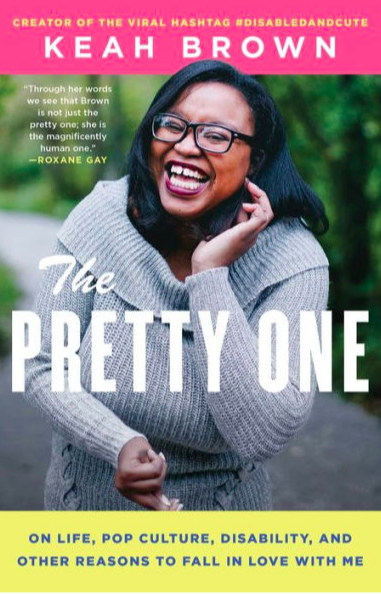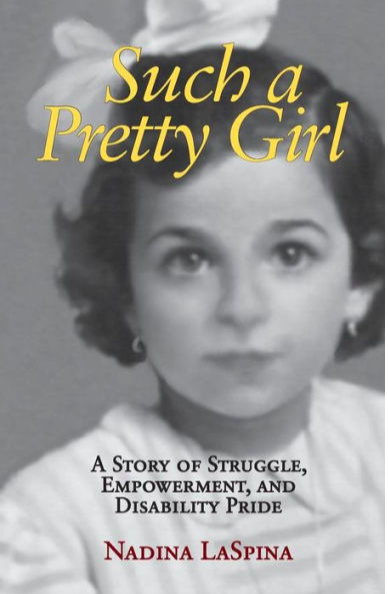Pretty Amazing: Two Disabled Activist Memoirs
It might seem like a coincidence: two books released in the same season with "pretty" in the title by disability activists. But the reasons are far more than skin deep. Both authors were told how attractive they were, with the implication or outright statement added that this beauty was wasted on a disabled person. Both Keah Brown and Nadia LaSpina write against the incorrect and cruel assumption that a disabled life is not a full, vibrant, and beautiful life. Both Brown and LaSpina vocally resist being, as Brown writes, "anyone's worst case scenario."Keah Brown's The Pretty One: On Life, Pop Culture, Disability, and other Reasons to Fall in Love with Me (Atria Books, 2019) is a thoughtful, funny, and deep conversation with a  young activist and author who is destined to become a prominent essayist and to remain at the forefront of thinking about disability. Brown critiques representations of disability in popular culture but also uses her life experience to trace the ways that representation of Black and disabled people in media, advertising, and popular culture have mattered to her. But this book is not only essays about popular culture. As the subtitle indicates, it's also reasons to fall in love with the author, one of the main reasons being her voice and her ability to unwind and reflect on the complex ways that marginalization due to disability has affected her relationships. Brown takes herself to task for the ways in which her unknowing envy of her twin sister affected her bond with her twin. She takes on critiques of identity politics, talks back to Twitter trolls, praises fashion as an engagement with her own beauty, and underlines the fact that she's asking for more than representation for disabled people, who also need respect and concrete assistance including access to housing, education, and employment. She delves into depression and self-harm, scars and the support she's received from friends and family, analyzing what that support has meant and how she returned it and reacted to it. Brown's depth, vulnerability, strength, and clear vision will snare your heart. This book should be in every high school and college library.Nadina LaSpina's Such a Pretty Girl: A Story of Struggle, Empowerment, and Disability Pride is a riveting chronicle of a coming-to-political awareness and then a long
young activist and author who is destined to become a prominent essayist and to remain at the forefront of thinking about disability. Brown critiques representations of disability in popular culture but also uses her life experience to trace the ways that representation of Black and disabled people in media, advertising, and popular culture have mattered to her. But this book is not only essays about popular culture. As the subtitle indicates, it's also reasons to fall in love with the author, one of the main reasons being her voice and her ability to unwind and reflect on the complex ways that marginalization due to disability has affected her relationships. Brown takes herself to task for the ways in which her unknowing envy of her twin sister affected her bond with her twin. She takes on critiques of identity politics, talks back to Twitter trolls, praises fashion as an engagement with her own beauty, and underlines the fact that she's asking for more than representation for disabled people, who also need respect and concrete assistance including access to housing, education, and employment. She delves into depression and self-harm, scars and the support she's received from friends and family, analyzing what that support has meant and how she returned it and reacted to it. Brown's depth, vulnerability, strength, and clear vision will snare your heart. This book should be in every high school and college library.Nadina LaSpina's Such a Pretty Girl: A Story of Struggle, Empowerment, and Disability Pride is a riveting chronicle of a coming-to-political awareness and then a long commitment to disability justice. LaSpina relays her story with deft writing and riveting scenes, beginning with her family's emigration from Sicily, her treatment for polio in the United States, and her later symptoms of post-polio syndrome. Along the way LaSpina shares generous detail about her friendships, including suicide of a vivacious disabled friend who felt trapped by isolation and cultural prejudice. She shares her loves and longing, her fight for educational opportunities and her career teaching Italian and then moving into Disability Studies. This extremely well-crafted personal narrative is made even more powerful because of the activism that LaSpina joins throughout the decades and the sustenance and community that activism provides. LaSpina even travels to Italy with a beau and connects with disability activists there, providing critical help to spur on international organizing.Her story provides an important eyewitness account to the campaigns of disabled activists in the United States, from the organizing for disabled parking and public transportation access in New York City to the fight for Section 504 of the Rehabilitation Act of 1973 and to the long decades of struggle toward the Americans with Disabilities Act, which she's careful to point out was watered down and is not a solution to the needs of disabled people. LaSpina was deeply involved in ADAPT and Disabled in Action (DIA, founded in 1970) and the many public protests and actions in New York, DC, and elsewhere that put these organizations on the map. The view inside the triumphs and heartbreaks of organizing, as well as the ways in which the disability rights movement gained inspiration and models from the Civil Rights Movement and the movement for LGBTQ+ rights are fascinating, and the history is relayed in a way that makes it come alive, with activists who LaSpina tracks through various organizations. A later return to Italy allows LaSpina to track the ways in which the two countries meet or do not meet needs for accessibility and healthcare.There's sex, stolen kisses, heartbreak, rough decisions to be made, loss, and plenty of Italian food. She navigates losing both of her parents and falling in love, as well as delaying marriage the love of her life because it would have interfered with his Medicaid and healthcare access. Like Brown, LaSpina battles against toxic pity. She is a human being, not an "inspiring" two-dimensional story, and she offers her own conflicts and doubts to let the reader fully into the complexity of her life. This book would be a perfect addition to any disability studies or creative nonfiction course, as it offers a great example of seamlessly melding the personal narrative with social context.
commitment to disability justice. LaSpina relays her story with deft writing and riveting scenes, beginning with her family's emigration from Sicily, her treatment for polio in the United States, and her later symptoms of post-polio syndrome. Along the way LaSpina shares generous detail about her friendships, including suicide of a vivacious disabled friend who felt trapped by isolation and cultural prejudice. She shares her loves and longing, her fight for educational opportunities and her career teaching Italian and then moving into Disability Studies. This extremely well-crafted personal narrative is made even more powerful because of the activism that LaSpina joins throughout the decades and the sustenance and community that activism provides. LaSpina even travels to Italy with a beau and connects with disability activists there, providing critical help to spur on international organizing.Her story provides an important eyewitness account to the campaigns of disabled activists in the United States, from the organizing for disabled parking and public transportation access in New York City to the fight for Section 504 of the Rehabilitation Act of 1973 and to the long decades of struggle toward the Americans with Disabilities Act, which she's careful to point out was watered down and is not a solution to the needs of disabled people. LaSpina was deeply involved in ADAPT and Disabled in Action (DIA, founded in 1970) and the many public protests and actions in New York, DC, and elsewhere that put these organizations on the map. The view inside the triumphs and heartbreaks of organizing, as well as the ways in which the disability rights movement gained inspiration and models from the Civil Rights Movement and the movement for LGBTQ+ rights are fascinating, and the history is relayed in a way that makes it come alive, with activists who LaSpina tracks through various organizations. A later return to Italy allows LaSpina to track the ways in which the two countries meet or do not meet needs for accessibility and healthcare.There's sex, stolen kisses, heartbreak, rough decisions to be made, loss, and plenty of Italian food. She navigates losing both of her parents and falling in love, as well as delaying marriage the love of her life because it would have interfered with his Medicaid and healthcare access. Like Brown, LaSpina battles against toxic pity. She is a human being, not an "inspiring" two-dimensional story, and she offers her own conflicts and doubts to let the reader fully into the complexity of her life. This book would be a perfect addition to any disability studies or creative nonfiction course, as it offers a great example of seamlessly melding the personal narrative with social context.